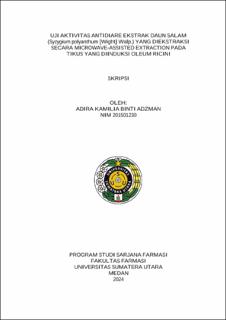Uji Aktivitas Antidiare Ekstrak Daun Salam (Syzygium polyanthum [Wight] Walp.) yang Diekstraksi secara Microwave-Assisted Extraction pada Tikus yang Diinduksi Oleum Ricini
Anti-Diarrheal Activity of Bay Leaf (Syzygium polyanthum [Wight] Walp.) Extracted with Microwave-Assisted Extraction on Castor Oil Induced Rats

Date
2024Author
Adzman, Adira Kamilia Binti
Advisor(s)
Nugraha, Sony Eka
Metadata
Show full item recordAbstract
Background: Bay leaf (Syzygium polyanthum [Wight] Walp.) is a well-known plant among the Indonesian people for treating diarrhea because they have astringent properties that can shrink mucous membranes, allowing more water to be absorbed and slowing down the defecation process. Microwave assisted extraction (MAE) is an extraction process that is easier, requiring fewer additional materials and equipment, and shortens the extraction time compared to conventional extraction methods.
Objective: To determine the antidiarrheal effect of bay leaf extract on white rats induced by castor oil.
Method: This study included the characterization of bay leaf simplicia, phytochemical screening tests, extraction using the MAE method with 70% ethanol, testing the total phenol content of bay leaves, and testing the antidiarrheal activity on 25 male white rats randomly divided into 5 groups. Group 1 served as the negative control and was given 1% CMC Na, Group 2 was the positive control and was given Diapet NR®, and Groups 3, 4, and 5 were given 20mg/kgBW, 40mg/kgBW, and 80mg/kgBW of bay leaf ethanol extract orally. Next, observations were made on the onset of diarrhea, stool consistency, stool weight, frequency of diarrhea, and duration of diarrhea.
Result: From the observations of the antidiarrheal effect test of bay leaf ethanol extract, there were no significant differences for the parameter of stool consistency and frequency of diarrhea. However, there were significant differences in the parameters of the onset of diarrhea, stool weight, and duration of diarrhea, indicating the antidiarrheal activity of bay leaf extract on male white rats. The bay leaf ethanol extract extracted using the microwave-assisted extraction (MAE) method contained phenol levels of 33.6884 ± 1.7780 mg GAE/g sample.
Conclusion: The study results indicate that there is an antidiarrheal effect from the bay leaf extract extracted using the MAE method.
Collections
- Undergraduate Theses [1834]
